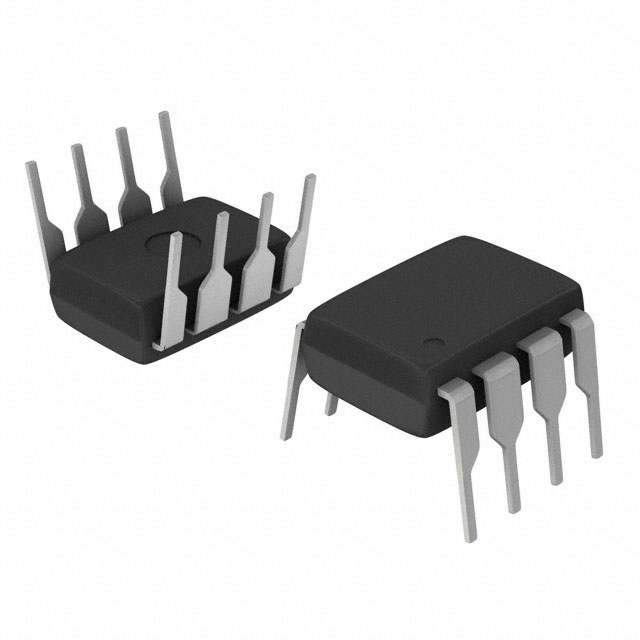Viz Specifikace pro podrobnosti o produktu.

LT1111CN8-12#PBF
Product Overview
Category
The LT1111CN8-12#PBF belongs to the category of integrated circuits (ICs) and specifically falls under the voltage regulators category.
Use
This product is primarily used as a step-up DC-DC converter. It provides a regulated output voltage that is higher than the input voltage.
Characteristics
- Input Voltage Range: 2V to 18V
- Output Voltage: 12V
- Maximum Output Current: 500mA
- Switching Frequency: 100kHz
- Package Type: DIP-8
- Operating Temperature Range: -40°C to 85°C
Package and Quantity
The LT1111CN8-12#PBF is packaged in a DIP-8 package, which stands for Dual In-line Package with 8 pins. It is commonly available in reels or tubes containing multiple units.
Specifications
- Input Voltage Range: 2V to 18V
- Output Voltage: 12V
- Output Current: Up to 500mA
- Switching Frequency: 100kHz
- Efficiency: Up to 90%
- Quiescent Current: 3.5mA
- Shutdown Current: 20μA
- Soft-Start Time: 10ms
- Operating Temperature Range: -40°C to 85°C
- Package Type: DIP-8
Pin Configuration
The LT1111CN8-12#PBF has eight pins arranged as follows:
```
| | --| Vout |-- --| GND |-- --| Vin |-- --| FB |-- --| SW |-- --| NC |-- --| NC |-- |_______| ```
- Vout: Output Voltage
- GND: Ground
- Vin: Input Voltage
- FB: Feedback Pin
- SW: Switching Pin
- NC: No Connection
Functional Features
- Step-up DC-DC Converter: The LT1111CN8-12#PBF efficiently boosts the input voltage to a regulated 12V output.
- Wide Input Voltage Range: It can accept input voltages ranging from 2V to 18V, making it versatile for various applications.
- High Efficiency: With an efficiency of up to 90%, it minimizes power losses during voltage conversion.
- Low Quiescent Current: The quiescent current of 3.5mA ensures low power consumption during operation.
- Soft-Start Functionality: The soft-start time of 10ms prevents excessive inrush current during startup.
Advantages
- Compact Size: The DIP-8 package allows for easy integration into electronic circuits.
- Wide Input Voltage Range: Enables compatibility with a broad range of input sources.
- High Efficiency: Reduces power dissipation and improves overall system efficiency.
- Soft-Start Functionality: Protects components from excessive current during startup.
Disadvantages
- Limited Maximum Output Current: The LT1111CN8-12#PBF can provide a maximum output current of 500mA, which may not be sufficient for high-power applications.
- Fixed Output Voltage: The output voltage is fixed at 12V, limiting its flexibility for applications requiring different output voltages.
Working Principles
The LT1111CN8-12#PBF operates as a step-up DC-DC converter using a switching regulator topology. It utilizes an internal oscillator to control the switching of an external power MOSFET. This switching action converts the input voltage to a higher regulated output voltage. The feedback pin (FB) monitors the output voltage and adjusts the duty cycle of the switching signal to maintain a stable 12V output.
Application Field Plans
The LT1111CN8-12#PBF finds applications in various fields, including: 1. Battery-powered devices: It can be used to step up battery voltages to power higher voltage components. 2. Automotive electronics: Enables voltage conversion for automotive systems requiring a regulated 12V supply. 3. Industrial equipment: Provides a stable 12V source for powering control circuits and sensors. 4. Telecommunications: Used in telecom infrastructure to convert lower voltages to 12V for powering communication modules.
Alternative Models
There are several alternative models available that offer similar functionality to the LT1111CN8-12#PBF. Some notable alternatives include: - LM2577: A popular step-up DC-DC converter with adjustable output voltage. - MC34063: Another widely used integrated circuit for step-up voltage conversion. - MAX1771: Offers high efficiency and adjustable output voltage options.
These alternative models provide flexibility in terms of output voltage adjustment and may better suit specific application requirements.
In conclusion, the LT1111CN8-12#P
Seznam 10 běžných otázek a odpovědí souvisejících s aplikací LT1111CN8-12#PBF v technických řešeních
Sure! Here are 10 common questions and answers related to the application of LT1111CN8-12#PBF in technical solutions:
Q1: What is the LT1111CN8-12#PBF? A1: The LT1111CN8-12#PBF is a step-up DC-DC converter IC manufactured by Linear Technology (now part of Analog Devices). It is designed to convert low voltage input to a higher regulated output voltage.
Q2: What is the input voltage range for LT1111CN8-12#PBF? A2: The input voltage range for LT1111CN8-12#PBF is typically between 1.5V and 10V.
Q3: What is the output voltage range for LT1111CN8-12#PBF? A3: The output voltage range for LT1111CN8-12#PBF is fixed at 12V.
Q4: What is the maximum output current of LT1111CN8-12#PBF? A4: The maximum output current of LT1111CN8-12#PBF is typically around 500mA.
Q5: Can LT1111CN8-12#PBF be used as a battery charger? A5: No, LT1111CN8-12#PBF is not specifically designed for battery charging applications. It is primarily used as a step-up voltage regulator.
Q6: What is the efficiency of LT1111CN8-12#PBF? A6: The efficiency of LT1111CN8-12#PBF depends on various factors such as input voltage, output current, and load conditions. Generally, it can achieve efficiencies above 80%.
Q7: Is LT1111CN8-12#PBF suitable for automotive applications? A7: Yes, LT1111CN8-12#PBF is suitable for automotive applications as it can operate over a wide temperature range and has built-in protection features.
Q8: Can LT1111CN8-12#PBF be used in battery-powered devices? A8: Yes, LT1111CN8-12#PBF can be used in battery-powered devices as it can efficiently step up the low battery voltage to a higher regulated voltage.
Q9: Does LT1111CN8-12#PBF require external components for operation? A9: Yes, LT1111CN8-12#PBF requires external components such as inductors, capacitors, and resistors for proper operation.
Q10: What are some typical applications of LT1111CN8-12#PBF? A10: Some typical applications of LT1111CN8-12#PBF include powering LCD displays, driving LEDs, generating bias voltages, and providing power for sensors or other low-power devices.
Please note that these answers are general and may vary depending on specific design considerations and requirements.

